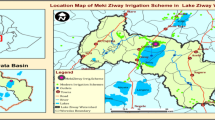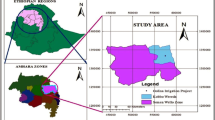Abstract
In this research we explore the potential of precision surface irrigation to improve irrigation performance under the warabandi system prevalent in the Indus Basin Irrigation System. Data on field dimensions, field slopes along with characteristic soil infiltration properties and outlet discharge were collected through a survey of a sample tertiary unit of Maira Branch Canal, Khyber Pakhtunkhwa Province, Pakistan. The performance of all fields in the tertiary unit was analysed and reported in aggregate, with detailed results of one field presented for illustration. The objective is to determine the optimum field layout, defined as the number of border strips, for the observed field characteristics to maximize performance. The results indicate that performance improvement is relatively easily achievable through changes in field layout within current irrigation services. Estimated application efficiency is sensitive to the selected depth of application, and it is important that a practical depth of application is selected. We recommend a depth of application of 50 mm and show how this is achievable and leads to a low quarter distribution uniformity of 0.750 and an application efficiency of 80 %. We also explore the feasibility of a 10-day warabandi rather than the 7-day warabandi and show that there is no significant change in the performance under a 10-day warabandi.








Similar content being viewed by others
Abbreviations
- a p :
-
Proportion of total available area cultivated
- D :
-
Depth of water supplied to the root zone (mm)
- \(\varepsilon_{\text{i}}\) :
-
Efficiency
- E :
-
Total number of efficiency terms
- N :
-
Number of border strips in the field
- q :
-
Discharge per unit width
- t :
-
Irrigation interval (s)
- t co :
-
Cut-off time for each border strip
- V :
-
Volume of water applied
- w N :
-
Width of each border strip and
- w a :
-
Water allowance (L s−1 ha−1)
References
ADB (2005) Pakistan: Pehur high-level canal Project, Project Completion Report Project Number: PAK 19141 Loan Number: 1294-PAK(SF). http://www.adb.org/sites/default/files/project-document/68796/19141-pak-pcr.pdf. Accessed June 2015
Anwar AA, Ul Haq Z (2013) An old–new measure of canal water inequity. Water Int 38(5):536–551
Bandaragoda DJ, Rehman SU (1995) Warabandi in Pakistan’s canal irrigation systems: widening gap between theory and practice. IIMI Country paper Pakistan No. 7, International Irrigation Management Institute, Sri Lanka, 89 pp
Bautista E, Clemmens AJ, Strelkoff TS, Niblack M (2009a) Analysis of surface irrigation systems with WinSRFR: example application. Agric Water Manag 96:1162–1169
Bautista E, Clemmens AJ, Strelkoff TS, Schlegel J (2009b) Modern analysis of surface irrigation systems with WinSRFR. Agric Water Manag 96:1146–1154
Bautista E, Schlegel JL, Strelkoff, TS (2012) WinSRFR 4.1 - User Manual. USDA-ARS Arid Land Agricultural Research Center. 21881 N. Cardon Lane, Maricopa, AZ, USA
Bautista E, Schlegel JL, Clemmens AJ (2015) The SRFR 5 modeling system for surface irrigation. J Irrig Drain Eng (on line)
Bishop AA, Long AK (1983) Irrigation water delivery for equity between users. J Irrig Drain Eng 109(4):349–356
Bos MG, Burton MA, Molden DJ (2005) Irrigation and drainage performance assessment, practical guidelines. CABI Publishing, Wallingford
Burt CM, Clemmens AJ, Strelkoff TS, Solomon KH, Bliesner RD, Hardy LA, Howell TA, Eisenhauer DE (1997) Irrigation performance measures: efficiency and uniformity. J Irrig Drain Eng ASCE 123(6):423–442
Chen B, Ouyang Z, Sun Z, Wu L, Li F (2012) Evaluation on the potential of improving border irrigation performance through border dimensions optimization: a case study on the irrigation districts along the lower Yellow River. Springer, Berlin
Clemmens AJ (1986) Canal capacities for demand under surface irrigation. J Irrig Drain Eng ASCE 112(4):331–347
Clemmens AJ (1987) Arranged delivery schedules. In: Planning, operation, rehabilitation and automation of irrigation water delivery systems, proceedings symposium, ASCE irrigation and drainage division specialty conference, ASCE, pp 57–67
Clemmens AJ, Bos MG (1990) Statistical methods for irrigation system water delivery performance evaluation. Irrigat Drain Syst 4:345–365
Clemmens AJ, Dedrick AR (1982) Limits for practical level-basin design. J Irrig Drain Div Am Soc Civ Eng 108(IR2):127–141
Clemmens AJ, Dedrick (1994) Irrigation techniques and evaluations. Advanced Series in Agricultural Sciences, vol 22. Springer, Berlin, pp 64–103
Clemmens AJ, Dedrick AR,Strand RJ (1995) BASIN 2.0. A computer program for the design of level-basin irrigation systems. WCL Report #19, U.S. Water Conservation Laboratory, Phoenix, AZ, USA
Clyma W, Ali A (1977) Traditional and improved irrigation practices in Pakistan. In: Proceedings of ASCE conference on water management for irrigation and drainage practices, ASCE, Reston, VA, pp 201–216
De Vries TT, Anwar AA (2004) Irrigation scheduling I: integer programming approach. J Irrig Drain Eng 130(1):9–16
Donaldson M, Bangash HD, Stacey DB (2003) Swabi salinity control and reclamation project. Proc ICE-Water Marit Eng 156(1):85–95
Frenken K (ed) (2012) Irrigation in Southern and Eastern Asia in figures: Aquastat survey, 2011. Food and Agriculture of the United Nations
Ghuman AR, Khan MZ, Khan AH, Munir S (2010) Assessment of operational strategies for logical and optimal use of irrigation water in a downstream control system. Irrig Drain 59:117–128
Gonzalez C, Cervera L, Moret-Fernandez D (2011) Basin irrigation design with longitudinal slope. Agric Water Manag 98:1516–1522
Humphreys E, Kukal SS, Christen EW, Hira GS, Balwinder-Singh S-Y, Sharma RK (2010) Halting the groundwater decline in North West India—which crop technologies will be winners? Adv Agron 109(2010):155–217
Hussain I, Hussain Z, Maqbool H, Akram SW, Farhan MF (2011) Water balance, supply and demand and irrigation efficiency of Indus basin. Pak Econ Soc Rev 49(1):13–38
Jat ML, Chandna P, Gupta R, Sharma SK, Gill MA (2006) Laser land leveling: a precursor technology for resource conservation. In: Rice–Wheat Consortium for the Indo-Gangetic Plains, New Delhi, India. Rice-Wheat Consortium Technical Bulletin 7
Kahlown MA, Kemper WD (2005) Reducing water losses from channels using linings: costs and benefits in Pakistan. Agric Water Manag 74:57–76
Latif M, Tariq JA (2009) Performance assessment of irrigation management transfer from government-managed to farmer-managed irrigation system: a case study. Irrig Drain 58:275–286
Laycock A, Swayne C, Marques JEJ (2005) Pehur High Level Canal, NWFP, Pakistan. J Water Manag
Lecina S, Playan E, Isidoro D, Dechmi F, Causape J, Faci JM (2005) Irrigation evaluation and simulation at the Irrigation District V of Bardenas (Spain). Agric Water Manag 73:223–245
McCornick PG (1993) Water management in arranged-demand canal. J Irrig Drain Eng 119(2):251–264
Niblack M (2005) US Department of Interior—U.S. Bureau of Reclamation. Yuma Area Office. Internal Report
Reddy JM (2013) Design of level-basin irrigation systems for robust performance. J Irrig Drain Eng ASCE 139(3):254–260
Salvador R, Latorre B, Paniagua P, Playán E (2011) Farmers’ scheduling patterns in on-demand pressurized irrigation. Agric Water Manag 102:86–96
Sarki A, Memon SQ, Lehghari M (2008) Comparison of different methods for computing seepage losses in earthen watercourse. Agricultura Tropica et SubTropica 41(4):197–205
Seckler D, Sampath RK, Raheja SK (1998) An index for measuring the performance of irrigation management systems with an application. Water Resour Bull 24(4):855–860
Strelkoff TS, Clemmens AJ, Schmidt BV, Slosky EJ (1996) BORDER—a design and management aid for sloping border irrigation systems. WCL Report 21. US Department of Agriculture Agricultural Research Service, U.S. Water Conservation Laboratory, Phoenix, AZ
Strelkoff TS, Clemmens AJ, Schmidt BV (1998) SRFR, Version 3.31—A model for simulating surface irrigation in borders, basins and furrows. US Department of Agriculture Agricultural Research Service, U.S. Water Conservation Laboratory, Phoenix, AZ
Tyagi NK, Kaushal RK, Ram S, Samptah RK (2012) Towards determining the optimal size of unit irrigation command area. Int J Water Resour Dev 9(4):425–438
US Department of Agriculture, Natural Resources and Conservation Service (2012). National Engineering Part 623 Irrigation Chapter 4
Wattenburger PL, Clyma W (1989a) Level basin design and management in the absence of water control part I: evaluation of completion-of-advance irrigation. Trans Am Soc Agric Eng 32(2):838–843
Wattenburger PL, Clyma W (1989b) Level basin design and management in the absence of water control part II: design method for completion-of-advance irrigation. Trans Am Soc Agric Eng 32(2):844–850
World Bank (2016) PK Punjab Irrig Agri Productivity Improvement Prog Phase-I. http://www.worldbank.org/projects/P125999/punjab-irrigation-productivity-improvement-program-project-phase-i?lang=en. Accessed 27 May 2015
Zeb J, Ahmad S, Aslam M, Badruddin. (2000) Evaluation of conveyance losses in three unlined watercourses of the Warsak gravity canal. Pak J Biol Sci 3(2):352–353
Acknowledgments
The International Water Management Institute (IWMI) is in receipt of financial support from the Embassy of the Kingdom of Netherlands, Islamabad, Pakistan, through Grant #22294, the United Nations University, Institute of Sustainability and Peace Grant# 600UU 848 and the CGIAR Research Program on Water, Land and Ecosystems (WLE) which were used in part to support this study. The authors would like to acknowledge the contribution of research interns, Shamoil Bin Akram and Khan Abdul Hannan. The study design, data collection, analysis and interpretation of the results are exclusively those of the authors.
Author information
Authors and Affiliations
Corresponding author
Additional information
Communicated by A. Kassam.
Rights and permissions
About this article
Cite this article
Anwar, A.A., Ahmad, W., Bhatti, M.T. et al. The potential of precision surface irrigation in the Indus Basin Irrigation System. Irrig Sci 34, 379–396 (2016). https://doi.org/10.1007/s00271-016-0509-5
Received:
Accepted:
Published:
Issue Date:
DOI: https://doi.org/10.1007/s00271-016-0509-5




